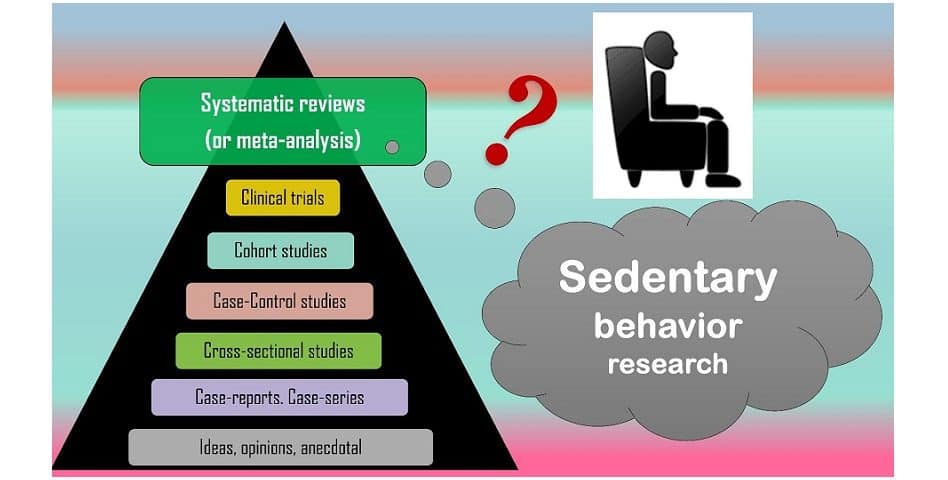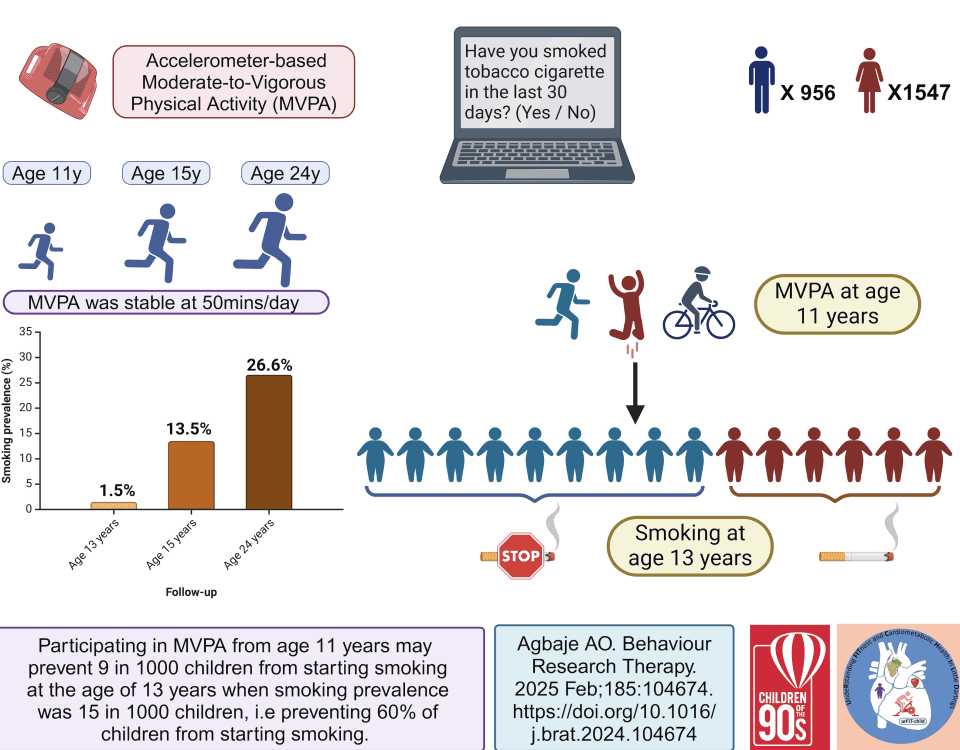
A Comparison of Associations Between Self-Reported and Device-Based Sedentary Behavior and Obesity Markers in Adults: A Multi-National Cross-Sectional Study
June 2, 2021
Association of sedentary patterns with body fat distribution among US children and adolescents: a population-based study
June 18, 2021Today’s blog post comes from Aamir Raoof Memon, an Assistant Professor at the Peoples University of Medical and Health Sciences for Women, Pakistan. In this blog, Aamir describes his paper titled “Sedentary behaviour research in adults: A scoping review of systematic reviews and meta-analyses”, which has recently been published in the Journal of Sports Sciences (available here). More about the author can be found at the bottom of this post.
Memon AR, Stanton R, To Q, et al. Sedentary behaviour research in adults: A scoping review of systematic reviews and meta-analyses [published online ahead of print, 2021 May 19]. J Sports Sci. 2021;1-13. doi:10.1080/02640414.2021.1928382
Why was this review needed?
Sedentary behavior has been associated with several adverse physical and psychological health outcomes in adults, independent of moderate to vigorous physical activity.[1, 2] Although the first paper on sedentary behavior was published in 1953, it was considered a distinct behavior, competing for time with physical activity and sleep throughout the day, only after 2010.[2–4] The behavioral epidemiology framework is used to categorize sedentary behavior research into six phases (i.e., relationship with health outcomes, development and validation of measurement tools, prevalence and variations within and across the populations, determinants and correlates, developing and testing interventions, and evidence to inform public health guidelines and policy).[5] Systematic reviews and meta-analyses are placed at the top of the hierarchy of evidence, and numerous systematic reviews and meta-analyses on sedentary behavior in adults have been conducted across all phases of behavioral epidemiology framework.[6,7] However, no any study has yet mapped sedentary behavior research in adults across the phases of behavioral epidemiology framework. Therefore, this scoping review was conducted to map the evidence from systematic reviews and meta-analyses on sedentary behavior in adults, as well as determine, through a bibliometric approach, the main contributors to this evidence. This is important to understand the spread, gaps, quality, and the main contributors to the systematic evidence on sedentary behavior, and provide directions for future research.
How was this review conducted?
We searched eight bibliographic databases for peer-reviewed journal publications in English language that systematically reviewed and/or meta-analyzed sedentary behavior, across the phases of behavioral epidemiology framework, in adults (≥18 years) – did not combine all age groups and/or did not examine sedentary behavior in combination with other health behaviors. Systematic and/or meta-analyses were first screened for eligibility, followed by extraction of information from them for this scoping review and bibliometric analysis.
What were the findings of the review?
Overall, we found 108 systematic and/or meta-analyses on sedentary behavior in adults, which were published between 2000 and 2020 (91.7% during 2010-2020). Of these, 54% reviews examined health outcomes associated with sedentary behavior and 26% focused on interventions to reduce sedentary behavior. No systematic reviews examined guidelines or policies on sedentary behavior in adults. Please refer to the supplemental material here for detailed findings of this scoping review. The findings for reporting and methodological quality of systematic and/or meta-analyses are reported in Fig 1.

Top 3 contributing countries were the United Kingdom, Australia and Canada. The leading institution was Baker Heart and Diabetes Institute (Australia), the most active author was Neville Owen (Australia) and the most contributing journal was Preventive Medicine. Top 10 authors publishing systematic reviews and/or meta-analyses on sedentary behavior in adults were from Australia, the United Kingdom and the Netherlands. The review titled “Sedentary time and its association with risk for disease incidence, mortality, and hospitalization in adults a systematic review and meta-analysis” was the most cited publication (more details on bibliometric parameters can be found here).
What do findings of this study mean?
This is the first review to map the evidence from the systematic reviews and meta-analyses on sedentary behavior in adults. While the evidence on health outcomes and interventions associated with sedentary behavior is high enough to conduct umbrella reviews or overviews of reviews in the future, there is limited evidence on other aspects (stage 2: measurement/validation; stage 3: prevalence/trends; stage 4: determinants/correlates) of behavioral epidemiology framework. No reviews on sedentary behavior policy were found because such reviews, conducted to date, have examined sedentary behavior policy in combination with other health behaviors (e.g., physical activity; see for example, Pogrmilovic et al., 2019). The recommendations based on the findings of this scoping review can be found in Box 1.
In the light of bibliometric findings of this review, researches from high-income countries (e.g., Australia, the UK, the USA) should aim to foster collaboration with researchers from low- and middle-income countries – to be inclusive. This scoping review is one such example.
Interested in our review? Please give it a read here – and the supplemental material here.
References:
- De Rezende LF, Lopes MR, Rey-López JP, Matsudo VK, do Carmo Luiz O. Sedentary behavior and health outcomes: an overview of systematic reviews. PLoS One. 2014; 9(8): e105620. [doi: 10.1371/journal.pone.0105620]
- Dumuid D, Stanford TE, Martin-Fernández JA, Pedišić Ž, Maher CA, Lewis LK, Hron K, Katzmarzyk PT, Chaput JP, Fogelholm M, Hu G. Compositional data analysis for physical activity, sedentary time and sleep research. Stat Methods Med Res. 2018; 27(12): 3726–38. [doi: 10.1177/0962280217710835]
- Morris JN, Heady JA, Raffle PAB, Roberts CG, Parks JW. Coronary heart-disease and physical activity of work. Lancet. 1953; 262(6796), 1111–20. [doi: 10.1016/s0140-6736(53)91495-0]
- Tremblay MS, Aubert S, Barnes JD, Saunders TJ, Carson V, Latimer-Cheung AE, Chastin SF, Altenburg TM, Chinapaw MJ. Sedentary behavior research network (SBRN)–terminology consensus project process and outcome. Int J Behav Nutr Phys Act. 2017; 14(1): 75. [doi: 10.1186/s12966-017-0525-8]
- Sallis JF, Owen N, Fotheringham MJ. Behavioral epidemiology: a systematic framework to classify phases of research on health promotion and disease prevention. Ann Behav Med. 2000; 22(4) :294–8. [doi: 10.1007/BF02895665]
- Ahn E, Kang H. Introduction to systematic review and meta-analysis. Korean J Anesthesiol. 2018; 71(2): 103–12. [doi: 10.4097/kjae.2018.71.2.103]
- Memon AR, Stanton R, To Q, Schoeppe S, Urooj A, Alley S, Hayman M, Vandelanotte C. Sedentary behaviour research in adults: A scoping review of systematic reviews and meta-analyses. J Sports Sci. 2021; 1–13 (ahead of print). [doi: 10.1080/02640414.2021.1928382]
About the author

Aamir completed Master of Philosophy (Health, Physical Education and Sports Sciences) in 2018 and then earned a Post-Graduate Diploma (Biomedical Ethics) in 2019. He is now looking forward to formally start his PhD. His broad areas of interest include 24-hour movement behaviors (physical activity, sedentary behavior, and sleep) and their interaction with health, medical education and research/publishing ethics. Aamir is currently Assistant Professor at the Institute of Physiotherapy and Rehabilitation Sciences, Peoples University of Medical and Health Sciences for Women, Nawabshah (Shaheed Benazirabad), Pakistan. He also holds positions on the editorial boards of some journals.




